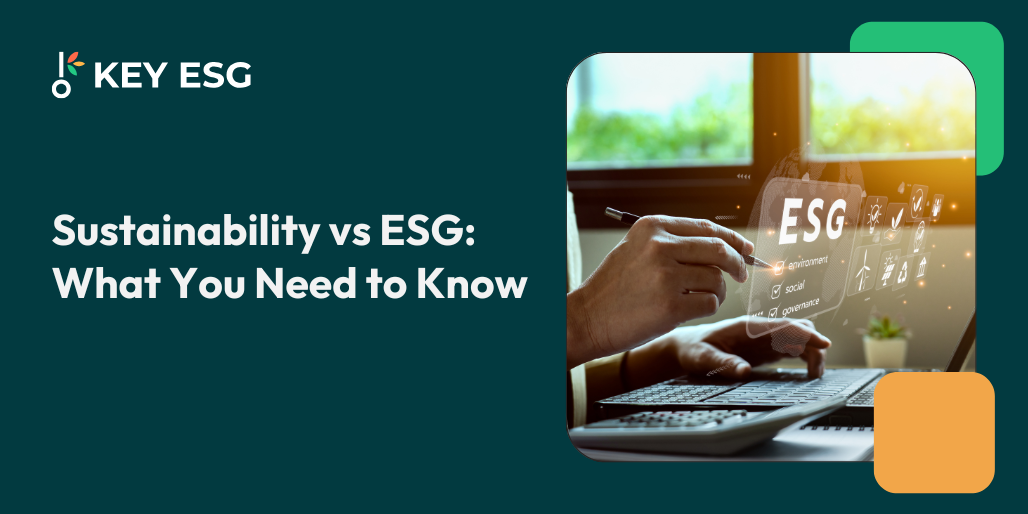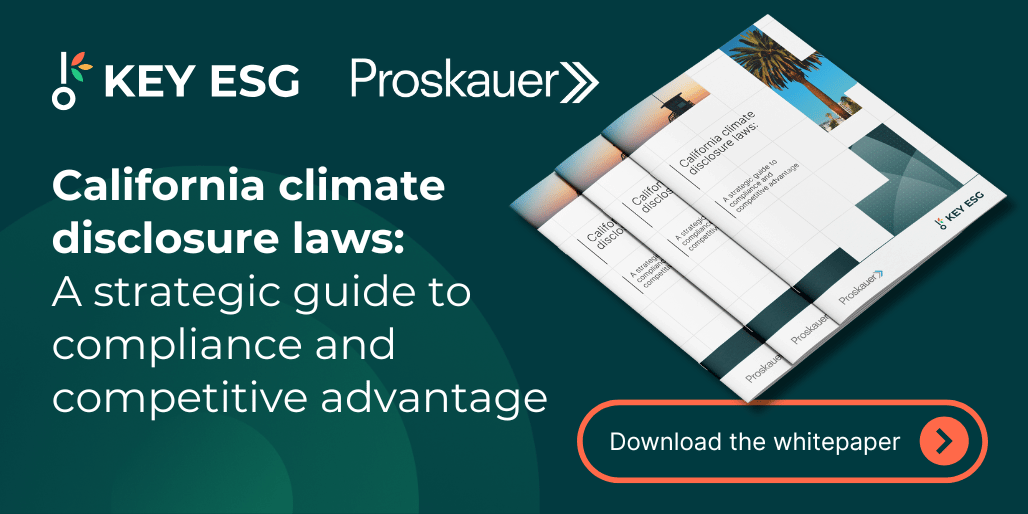Organisations face pressure not only to define their values but also to demonstrate impact. Stakeholders, including institutional investors, regulatory bodies, customers, and employees, expect companies to show measurable progress on environmental and social impacts, climate change, ethical business practices, and governance.
Amid this pressure, two terms often used interchangeably can cause confusion: sustainability and ESG. While closely related, they are not the same. A clear understanding of each helps companies align sustainability goals with reporting frameworks, manage ESG risks, and support long-term sustainable growth.
This article breaks down the subtle differences and explains how using the correct language which resonates with various stakeholder audiences, can enable an organisation to gain buy-in for its sustainability activities and ESG reporting commitments.

What sustainability means
Sustainability refers to a company’s long-term commitment to operating in a way that protects people, the planet, and future generations. It is about aligning an enterprise around long-term value creation that accounts for environmental, societal, and economic health, while embedding impact into strategy, operations, innovation, and culture.
As a broader concept, sustainability includes corporate social responsibility (CSR) initiatives such as community programmes, ethical sourcing, employee wellbeing efforts, and environmental goals such as reducing carbon emissions, minimising waste, and sustainable supply chain management.
Sustainable business practices encompass reducing greenhouse gas emissions, promoting employee diversity, utilising renewable energy, and fostering responsible business practices throughout global supply chains.
What ESG stands for
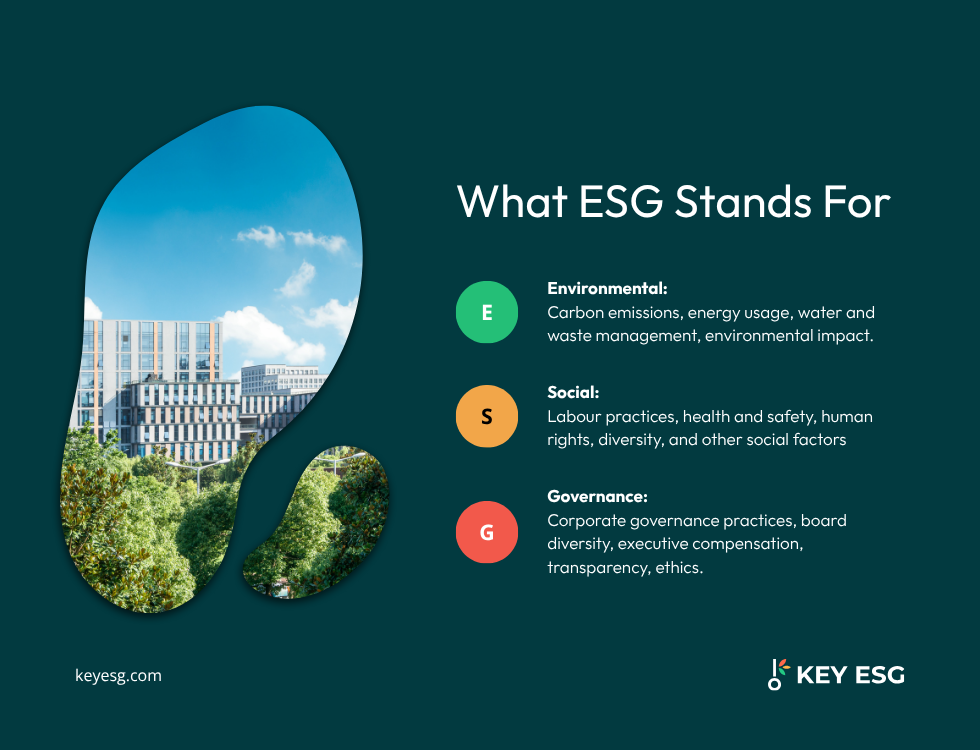
ESG - Environmental, Social, and Governance - is the term given to a reporting framework that evaluates a company's performance against sustainability goals using defined criteria and measurable data. ESG reporting turns purpose into performance by defining a set of metrics and data points which a company reports against.
ESG has three key components:
- Environmental: Carbon emissions, energy usage, water and waste management, environmental impacts and risks.
- Social: Labour practices, health and safety, human rights, diversity, and other social factors.
- Governance: Corporate governance practices, board diversity, executive compensation, transparency and ethics.
ESG frameworks provide a measured assessment of a company’s impact, using recognised reporting frameworks such as:
- The IFRS Foundation’s ISSB S1 and S2 standards
- The Corporate Sustainability Reporting Directive (CSRD)
- The California Climate Disclosure Laws
- Task Force on Nature-Related Financial Disclosures (TNFD)
- The Sustainable Finance Disclosure Regulations (SFDR)
- ESG Data Convergence Initiative (EDCI)
Companies use these standards, and many others, to report in a structured and comparable manner. This allows ESG performance to be benchmarked and audited, critical for regulatory compliance and ESG investing.
Many organisations use platforms like KEY ESG to manage ESG disclosure and performance tracking. These platforms support sustainability reporting, data automation, and audit readiness.
Sustainability vs ESG: key differences
While closely connected, the terms sustainability and ESG carry different implications, which is why they should be used in different contexts when relating to a business’s sustainability activities.
The table below highlights the nuances of how the terms can be used in different contexts:
Purpose
Sustainability represents the company’s “why.” It’s the foundation for setting sustainability goals that reflect ethical and responsible business practices. ESG defines the “how.” It provides a system to measure and demonstrate the company’s performance on those goals.
Scope
Sustainability can include everything from producing sustainable products to rethinking business practices for environmental and social good. This includes sustainable practices aimed at reducing resource use, protecting ecosystems, and promoting environmental sustainability across operations.
Audience
Sustainability strategies are relevant and applicable for all of an organisations stakeholders including employees, consumers, customers, investors and regulators. ESG reports tend to be aimed at institutional investors, regulators, and ESG rating agencies who evaluate a company’s ability to manage risk and deliver financial performance in a sustainable manner.
Approach
A company’s sustainability performance is increasingly governed by both internal strategy and external regulation. Under regulations such as the Corporate Sustainability Reporting Directive (CSRD) and the California Climate Disclosure Laws, companies must provide detailed ESG data according to approved reporting frameworks or methodologies.
Failing to comply can affect access to capital, regulatory standing, and ESG scores, which influence investor behaviour.
Output
Sustainability efforts produce long-term strategies, public commitments, or community engagement programmes. ESG is the term more typically given to the reporting output. An ESG report would be a company’s sustainability metrics and data points and would be included in annual reports.
Read examples of ESG reports to see how sustainability and ESG data come together in practice.
Why the distinction matters
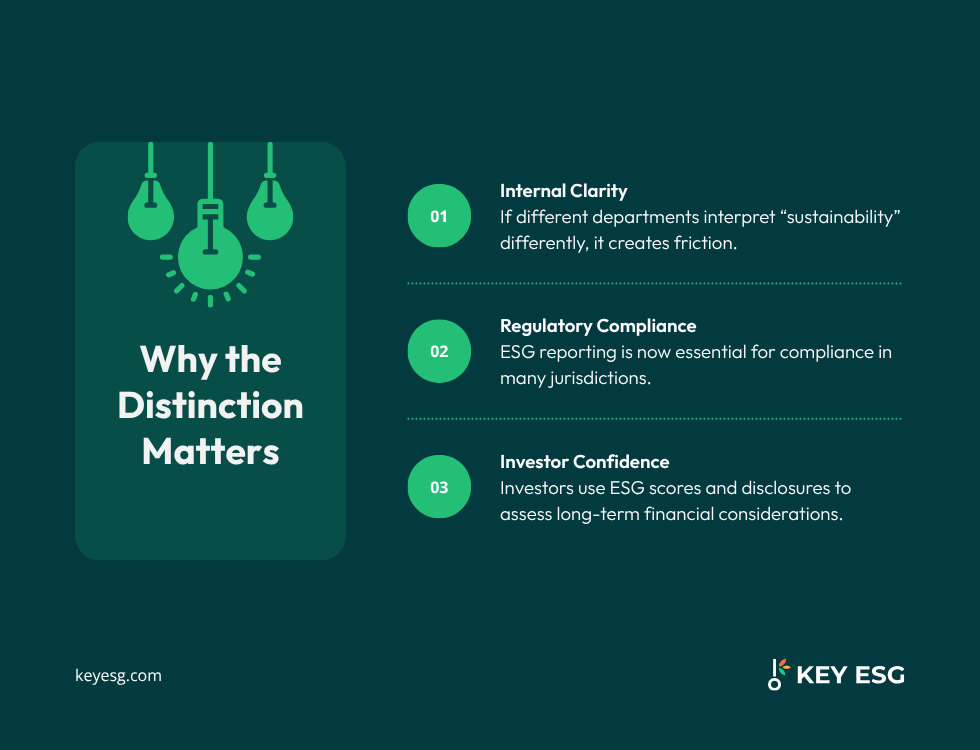
Sustainability and ESG may seem interchangeable, but how they are used and perceived has important consequences.
1. Strategic coherence vs. reporting optics
Sustainability reflects a company’s transparent strategies that deliver meaningful environmental, social, and economic impact. It embeds sustainability initiatives into long-term value creation. ESG, however, is typically associated with reporting: metrics, disclosures, and audits. While vital for accountability, ESG is sometimes criticised as formulaic or disconnected from genuine strategic intent.
2. Greenwashing and accountability
ESG has faced reputational risks due to greenwashing scandals. In 2025, Deutsche Bank’s DWS was fined €25 million for misrepresenting ESG credentials. Regulators worldwide have intensified oversight, while research shows many ESG funds risk misleading claims, including nearly a quarter of “Article 8” funds. These examples show why it’s critical to distinguish ESG reporting from sustainability strategy.
Explore more on ESG compliance and how to stay audit-ready.
3. Internal alignment and stakeholder language
In the aftermath of the greenwashing scandals, organisations sought to re-set their approaches to sustainability, enhance transparency of communication and improve stakeholder and investor trust. As a result, the term sustainability is now used more commonly as it represents the philosophy of aligning sustainability activities with business value-creation and transparent communication. Understanding your audiences, both internally and externally, is crucial to managing expectations, transparent communications and delivering measurable impact.
How Sustainability and ESG should work together
Sustainability goals set the direction. ESG reporting provides the structure to get there.
For example:
- A company wants to lower its environmental impact.
- It sets a sustainability goal: reduce carbon emissions by 30%.
- ESG frameworks define how to track Scope 1, 2, and 3 emissions, how progress should be disclosed, and how stakeholders can validate performance.
Tools like KEY ESG allow companies to collect, manage, and report data in line with global frameworks. This turns broad sustainability ambitions into trackable, verifiable outcomes.
Case examples: ESG supporting sustainability
Today, most companies treat both ESG and sustainability synonymously. The difference is that businesses that manage their sustainability communication successfully, adjust their terminology depending on their audience. They speak transparently about their sustainability goals and back up their targets with the highest-quality ESG data. Here are two great examples.
Salesforce
Salesforce promotes responsible business practices and climate leadership. Its ESG reporting covers climate-related financial disclosures, supply chain emissions, and employee diversity. The company uses SASB and GRI to standardise its reporting, linking sustainability commitments to performance metrics.
Unilever
Unilever’s corporate sustainability efforts are embedded across its brands. The company tracks its ESG performance using indicators such as waste management, water use, and governance practices. Its disclosures meet GRI and TCFD guidelines, helping investors assess its ESG risks and long-term value creation.
Both companies show how sustainability and ESG frameworks can coexist. Purpose informs vision. ESG frameworks provide evidence.
Getting started with your sustainability strategy
For companies looking to progress their sustainability strategies, the first step is clarity. Leaders need to define what matters, which data to track, and how to report it in a consistent, verifiable way.
Choose the right reporting framework
There’s no one-size-fits-all approach to sustainability and ESG reporting. The choice of framework depends on your industry, location, stakeholder expectations, and regulatory requirements. Common frameworks include:
- Corporate Sustainability Reporting Directive (CSRD): Mandatory for many companies in the EU. Requires detailed ESG disclosures aligned with the European Sustainability Reporting Standards (ESRS).
- California Climate Disclosure Laws: Mandatory for companies operating in California with revenues over $500 million. Eligible companies must report and disclose their Scope 1, 2, and 3 emissions.
- AASB and NGER reporting in Australia: It is mandatory for large organisations to report their Scope 1, 2 and 3 emissions in line with the NGER reporting standards.
- Global Reporting Initiative (GRI): Widely used across sectors. Emphasises stakeholder impact and transparency.
- IFRS S1 and S2: Globally recognised frameworks which are being adopted across an increasing number of countries (with some geographic adaptations).
Selecting the right framework (or combination) ensures that ESG reports are aligned with the expectations of the relevant audience, whether that’s regulators, investors, or internal leadership.
An ESG Reporting workflow with KEY ESG
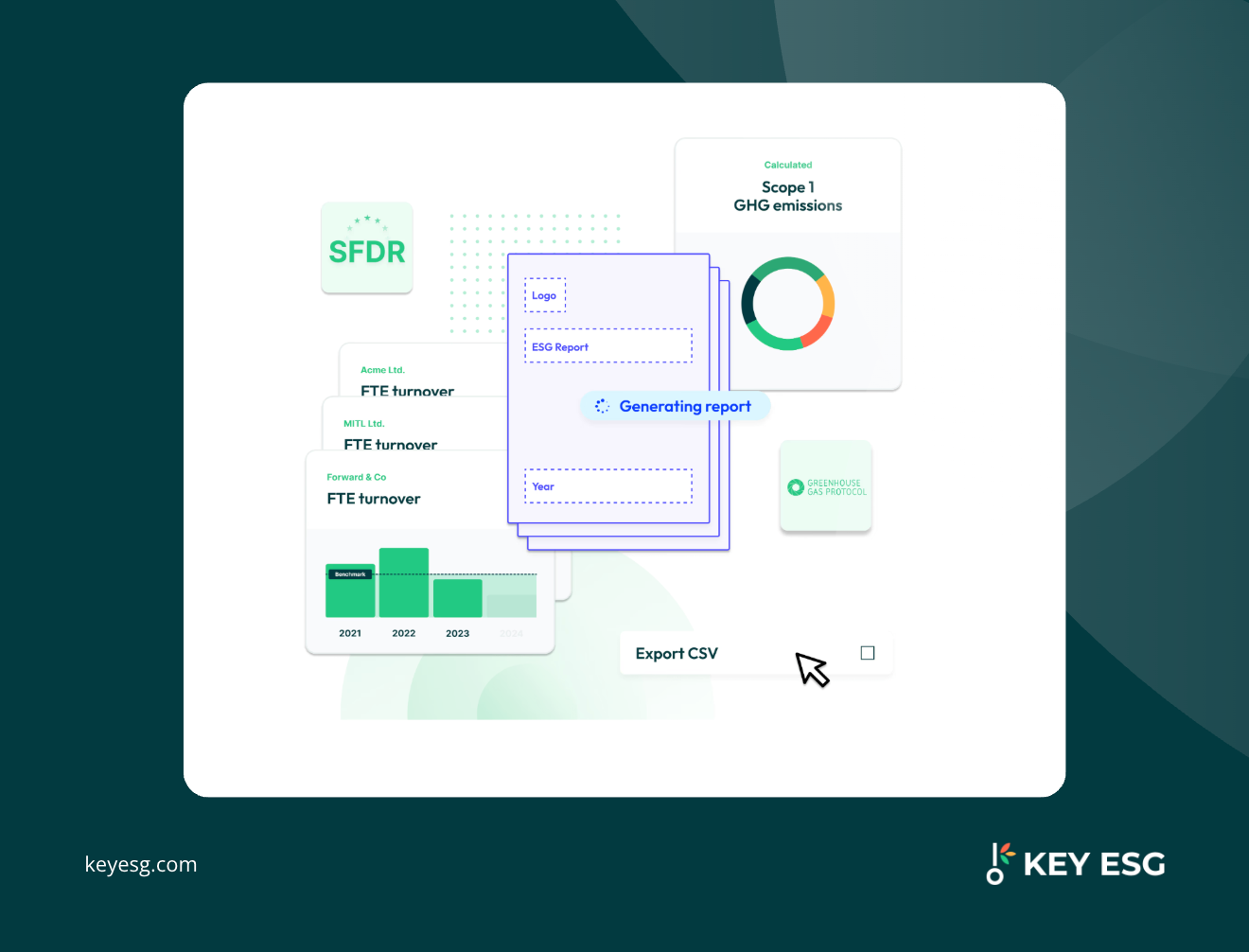
The KEY ESG platform supports companies at every stage of the reporting journey. A typical workflow looks like this:
- Define reporting scope: Identify material ESG topics based on your sector, size, and stakeholders.
- Map to frameworks: Choose reporting standards (e.g., GRI, CSRD) and connect them to data points across your organisation.
- Collect and validate data: Use integrated tools to gather ESG data from internal teams and suppliers, ensuring consistency, accuracy, and auditability.
- Analyse performance: Visualise ESG performance metrics across entities, regions, or timeframes.
- Generate disclosures: Produce standard-aligned ESG reports and dashboards tailored for regulators, investors, and internal teams.
This structured approach helps reduce reporting complexity, mitigates risk, and improves stakeholder confidence in ESG disclosures.
Start tracking your sustainability strategy today
In today’s regulatory landscape, organisations must do more than commit to sustainable practices, they must demonstrate impact through credible sustainability strategies and transparent communication. At the same time, structured, auditable ESG reporting remains essential for compliance, investor confidence, and accountability. Both sustainability and ESG drive alignment, trust, and long-term value.
KEY ESG helps companies turn sustainability goals into measurable outcomes. Our platform simplifies data collection, aligns with leading reporting frameworks, and equips teams to report confidently.
Ready to elevate your ESG reporting? Request a demo today.
Organisations face pressure not only to define their values but also to demonstrate impact. Stakeholders, including institutional investors, regulatory bodies, customers, and employees, expect companies to show measurable progress on environmental and social impacts, climate change, ethical business practices, and governance.
Amid this pressure, two terms often used interchangeably can cause confusion: sustainability and ESG. While closely related, they are not the same. A clear understanding of each helps companies align sustainability goals with reporting frameworks, manage ESG risks, and support long-term sustainable growth.
This article breaks down the subtle differences and explains how using the correct language which resonates with various stakeholder audiences, can enable an organisation to gain buy-in for its sustainability activities and ESG reporting commitments.

What sustainability means
Sustainability refers to a company’s long-term commitment to operating in a way that protects people, the planet, and future generations. It is about aligning an enterprise around long-term value creation that accounts for environmental, societal, and economic health, while embedding impact into strategy, operations, innovation, and culture.
As a broader concept, sustainability includes corporate social responsibility (CSR) initiatives such as community programmes, ethical sourcing, employee wellbeing efforts, and environmental goals such as reducing carbon emissions, minimising waste, and sustainable supply chain management.
Sustainable business practices encompass reducing greenhouse gas emissions, promoting employee diversity, utilising renewable energy, and fostering responsible business practices throughout global supply chains.
What ESG stands for

ESG - Environmental, Social, and Governance - is the term given to a reporting framework that evaluates a company's performance against sustainability goals using defined criteria and measurable data. ESG reporting turns purpose into performance by defining a set of metrics and data points which a company reports against.
ESG has three key components:
- Environmental: Carbon emissions, energy usage, water and waste management, environmental impacts and risks.
- Social: Labour practices, health and safety, human rights, diversity, and other social factors.
- Governance: Corporate governance practices, board diversity, executive compensation, transparency and ethics.
ESG frameworks provide a measured assessment of a company’s impact, using recognised reporting frameworks such as:
- The IFRS Foundation’s ISSB S1 and S2 standards
- The Corporate Sustainability Reporting Directive (CSRD)
- The California Climate Disclosure Laws
- Task Force on Nature-Related Financial Disclosures (TNFD)
- The Sustainable Finance Disclosure Regulations (SFDR)
- ESG Data Convergence Initiative (EDCI)
Companies use these standards, and many others, to report in a structured and comparable manner. This allows ESG performance to be benchmarked and audited, critical for regulatory compliance and ESG investing.
Many organisations use platforms like KEY ESG to manage ESG disclosure and performance tracking. These platforms support sustainability reporting, data automation, and audit readiness.
Sustainability vs ESG: key differences
While closely connected, the terms sustainability and ESG carry different implications, which is why they should be used in different contexts when relating to a business’s sustainability activities.
The table below highlights the nuances of how the terms can be used in different contexts:
Purpose
Sustainability represents the company’s “why.” It’s the foundation for setting sustainability goals that reflect ethical and responsible business practices. ESG defines the “how.” It provides a system to measure and demonstrate the company’s performance on those goals.
Scope
Sustainability can include everything from producing sustainable products to rethinking business practices for environmental and social good. This includes sustainable practices aimed at reducing resource use, protecting ecosystems, and promoting environmental sustainability across operations.
Audience
Sustainability strategies are relevant and applicable for all of an organisations stakeholders including employees, consumers, customers, investors and regulators. ESG reports tend to be aimed at institutional investors, regulators, and ESG rating agencies who evaluate a company’s ability to manage risk and deliver financial performance in a sustainable manner.
Approach
A company’s sustainability performance is increasingly governed by both internal strategy and external regulation. Under regulations such as the Corporate Sustainability Reporting Directive (CSRD) and the California Climate Disclosure Laws, companies must provide detailed ESG data according to approved reporting frameworks or methodologies.
Failing to comply can affect access to capital, regulatory standing, and ESG scores, which influence investor behaviour.
Output
Sustainability efforts produce long-term strategies, public commitments, or community engagement programmes. ESG is the term more typically given to the reporting output. An ESG report would be a company’s sustainability metrics and data points and would be included in annual reports.
Read examples of ESG reports to see how sustainability and ESG data come together in practice.
Why the distinction matters

Sustainability and ESG may seem interchangeable, but how they are used and perceived has important consequences.
1. Strategic coherence vs. reporting optics
Sustainability reflects a company’s transparent strategies that deliver meaningful environmental, social, and economic impact. It embeds sustainability initiatives into long-term value creation. ESG, however, is typically associated with reporting: metrics, disclosures, and audits. While vital for accountability, ESG is sometimes criticised as formulaic or disconnected from genuine strategic intent.
2. Greenwashing and accountability
ESG has faced reputational risks due to greenwashing scandals. In 2025, Deutsche Bank’s DWS was fined €25 million for misrepresenting ESG credentials. Regulators worldwide have intensified oversight, while research shows many ESG funds risk misleading claims, including nearly a quarter of “Article 8” funds. These examples show why it’s critical to distinguish ESG reporting from sustainability strategy.
Explore more on ESG compliance and how to stay audit-ready.
3. Internal alignment and stakeholder language
In the aftermath of the greenwashing scandals, organisations sought to re-set their approaches to sustainability, enhance transparency of communication and improve stakeholder and investor trust. As a result, the term sustainability is now used more commonly as it represents the philosophy of aligning sustainability activities with business value-creation and transparent communication. Understanding your audiences, both internally and externally, is crucial to managing expectations, transparent communications and delivering measurable impact.
How Sustainability and ESG should work together
Sustainability goals set the direction. ESG reporting provides the structure to get there.
For example:
- A company wants to lower its environmental impact.
- It sets a sustainability goal: reduce carbon emissions by 30%.
- ESG frameworks define how to track Scope 1, 2, and 3 emissions, how progress should be disclosed, and how stakeholders can validate performance.
Tools like KEY ESG allow companies to collect, manage, and report data in line with global frameworks. This turns broad sustainability ambitions into trackable, verifiable outcomes.
Case examples: ESG supporting sustainability
Today, most companies treat both ESG and sustainability synonymously. The difference is that businesses that manage their sustainability communication successfully, adjust their terminology depending on their audience. They speak transparently about their sustainability goals and back up their targets with the highest-quality ESG data. Here are two great examples.
Salesforce
Salesforce promotes responsible business practices and climate leadership. Its ESG reporting covers climate-related financial disclosures, supply chain emissions, and employee diversity. The company uses SASB and GRI to standardise its reporting, linking sustainability commitments to performance metrics.
Unilever
Unilever’s corporate sustainability efforts are embedded across its brands. The company tracks its ESG performance using indicators such as waste management, water use, and governance practices. Its disclosures meet GRI and TCFD guidelines, helping investors assess its ESG risks and long-term value creation.
Both companies show how sustainability and ESG frameworks can coexist. Purpose informs vision. ESG frameworks provide evidence.
Getting started with your sustainability strategy
For companies looking to progress their sustainability strategies, the first step is clarity. Leaders need to define what matters, which data to track, and how to report it in a consistent, verifiable way.
Choose the right reporting framework
There’s no one-size-fits-all approach to sustainability and ESG reporting. The choice of framework depends on your industry, location, stakeholder expectations, and regulatory requirements. Common frameworks include:
- Corporate Sustainability Reporting Directive (CSRD): Mandatory for many companies in the EU. Requires detailed ESG disclosures aligned with the European Sustainability Reporting Standards (ESRS).
- California Climate Disclosure Laws: Mandatory for companies operating in California with revenues over $500 million. Eligible companies must report and disclose their Scope 1, 2, and 3 emissions.
- AASB and NGER reporting in Australia: It is mandatory for large organisations to report their Scope 1, 2 and 3 emissions in line with the NGER reporting standards.
- Global Reporting Initiative (GRI): Widely used across sectors. Emphasises stakeholder impact and transparency.
- IFRS S1 and S2: Globally recognised frameworks which are being adopted across an increasing number of countries (with some geographic adaptations).
Selecting the right framework (or combination) ensures that ESG reports are aligned with the expectations of the relevant audience, whether that’s regulators, investors, or internal leadership.
An ESG Reporting workflow with KEY ESG

The KEY ESG platform supports companies at every stage of the reporting journey. A typical workflow looks like this:
- Define reporting scope: Identify material ESG topics based on your sector, size, and stakeholders.
- Map to frameworks: Choose reporting standards (e.g., GRI, CSRD) and connect them to data points across your organisation.
- Collect and validate data: Use integrated tools to gather ESG data from internal teams and suppliers, ensuring consistency, accuracy, and auditability.
- Analyse performance: Visualise ESG performance metrics across entities, regions, or timeframes.
- Generate disclosures: Produce standard-aligned ESG reports and dashboards tailored for regulators, investors, and internal teams.
This structured approach helps reduce reporting complexity, mitigates risk, and improves stakeholder confidence in ESG disclosures.
Start tracking your sustainability strategy today
In today’s regulatory landscape, organisations must do more than commit to sustainable practices, they must demonstrate impact through credible sustainability strategies and transparent communication. At the same time, structured, auditable ESG reporting remains essential for compliance, investor confidence, and accountability. Both sustainability and ESG drive alignment, trust, and long-term value.
KEY ESG helps companies turn sustainability goals into measurable outcomes. Our platform simplifies data collection, aligns with leading reporting frameworks, and equips teams to report confidently.
Ready to elevate your ESG reporting? Request a demo today.


